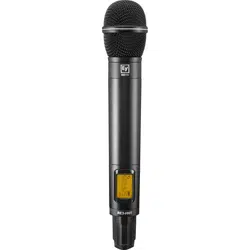Loading ...
Loading ...
Loading ...

RE3
UHF Wireless Troubleshooting and FAQ | en 65
Electro
-Voice Installation manual 2021.06 | 03 | F.01U.362.808
A – The transmitter input sensitivity likely needs to be adjusted. It has 30dB of adjustment
(-15dB at lowest gain to +15dB at highest gain). On the transmitter, press and hold SET
until the characters on the display begin to flash. Continue to progressively press SET until
reaching the sensitivity parameter. Press the up button to increase the displayed value.
Pressing SET will store the new setting. Continue working with this setting until the
receiver’s AF meter yellow LED is lighting upon high voice peaks. An occasional red LED
will be OK.
Q – My receiver is in lock mode. How do I unlock it?
A – Press and hold the SET button for two seconds then use down button to select OFF.
Then press SET. Receiver is unlocked.
Q – Why does my receiver RF meter show RF signal present before I turn on the mated
transmitter?
A – There is a competing RF signal now present on that frequency. With the RE3
transmitter off, follow the scan process and select a new clear frequency. Then turn on the
transmitter and resync it to the receiver’s new data.
Q – The frequency I’ve had my set tuned to has always worked flawlessly. Why is it that
when I traveled to an out-of-town gig, I’m getting interference there?
A – RF environments change city-to-city. When traveling, it’s important to remember that
UHF television broadcasts are not always on the same channel in every city. Something in
the city or venue you traveled to is different. Follow the scan process and select a new
clear frequency. Then turn on the transmitter and resync it to the receiver’s new data.
Q – Our RE3 systems have been working fine in the small venue we play. We decided to try
high power on the lead vocal mic transmitter, and now we’re having all kinds of problems.
What could be wrong?
A – In your small venue, high output power on any or all of your mics may be too much
because of transmitter-to-transmitter, and transmitter-to-receiver proximity. Too much RF
gain can actually be more destructive than low RF gain. High RF gain is most useful for
long transmission distances, but at short distances, it may contribute to intermodulation
with nearby transmitters and receivers. If the low power setting was working for you, switch
back to it.
Q – I have a long distance between where I want my antennas mounted and where the
receivers will be located. Do I need antenna boosters and high-end coax?
A – This might be a very good idea. The purpose of using antenna boosters and/or active
antennas is to compensate for the signal loss incurred by the antenna-to-receiver coax
cable run. The system you describe will be improved with active RF antenna components
and low-loss coax. Coax cable performance is measured by loss factors, i.e., dB of loss per
100 meters. The goal is to deliver to the receiver the approximate RF gain which is received
at the antenna. The RE3 optional antenna coax cables should perform as per: 25-foot
Loading ...
Loading ...
Loading ...
